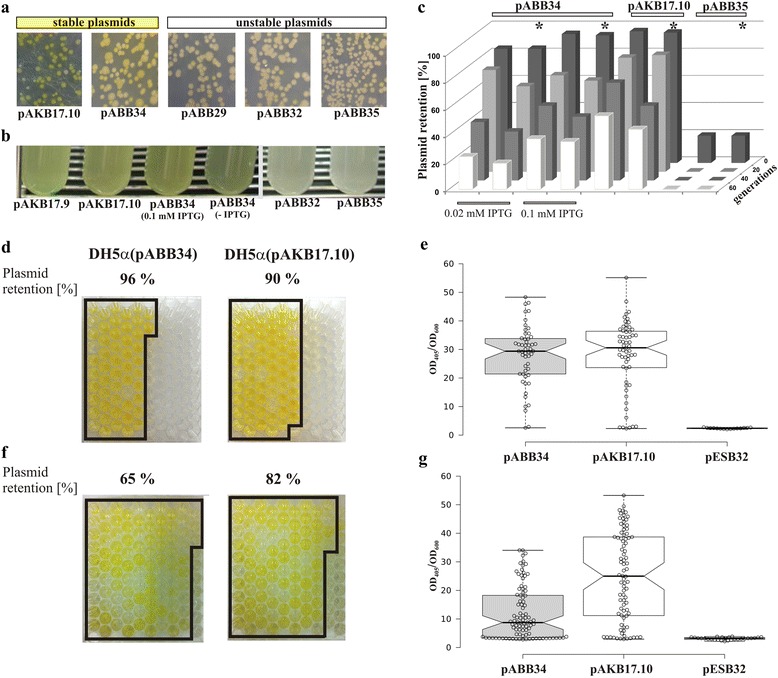Fig. 3.

Detection of plasmid retention on plates, in liquid cultures and by high-throughput quantification. a Transformants of E. coli DH5α with stable (pAKB17.10 or pABB34) and unstable (pABB29, pABB32 or pABB35) plasmids were grown for 20 generations without selection and IPTG and then 100 μl of 106-fold dilutions was plated on L agar, sprayed with 10 mM catechol and photographed. b Overnight cultures of E. coli DH5α transformants bearing indicated plasmids were grown for 20 generations in L broth and 0.1 mM IPTG where marked. Catechol was added to 1 mM to the cultures and after 5 min of incubation tubes were photographed. c Comparison of segregation data obtained in the standard replica plating test and visualization test (marked by asterisk) with the use of catechol as in (a). The results shown are representative of three independent experiments. d/f High-throughput quantification of plasmid retention in single-cell subcultures. Overnight cultures of DH5α(pAKB17.10) and DH5α(pABB34) grown in L broth with antibiotic (no IPTG added) were diluted to 5 cells ml−1 in L broth and aliquoted into 100-well plates (200 μl/well). After growth in Bioscreen (ca. 20 generations) the subcultures were diluted 100-fold into a new plate and 1/10 vol of 10 mM catechol was added to each well and photographed (d). Similar tests (f) were carried out after 40 generations of growth without selection (24 h in tubes followed by 24 h in Bioscreen plate). The photographs were taken after 10 min of incubation with catechol. The plasmid retention in liquid cultures (initial and after 20 generations of growth without selection in tubes) corresponds to the percentage of single-cell subcultures turning yellow. e/g The colour development quantified by OD405 after addition of catechol to the single-cell subcultures in the wells from (d) and (f), respectively. DH5α(pESB32) strain was used as a negative control. Plasmid segregation during growth without selection in the wells for 20 generations (e) and for total 40 generations (g) was reflected by variable level of XylE activity (OD405). OD405/OD600 ratio for each culture was plotted using BoxPlotR (boxplot.tyerslab.com; [55]). Boxes indicate the 25th and 75th percentiles and center lines show the medians. Whiskers mark minimum and maximum values in accordance with Spear criteria, and non-overlapping notches indicate that population medians are different with 95 % confidence as determined by R software
